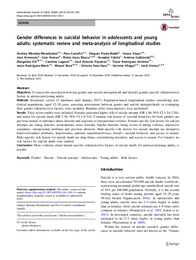Please use this identifier to cite or link to this item:
https://hdl.handle.net/11000/34600Full metadata record
| DC Field | Value | Language |
|---|---|---|
| dc.contributor.author | Miranda Mendizabal, Andrea | - |
| dc.contributor.author | Castellví, Pere | - |
| dc.contributor.author | Parés-Badell, Oleguer | - |
| dc.contributor.author | Alayo, Itxaso | - |
| dc.contributor.author | Almenara Barrios, José | - |
| dc.contributor.other | Departamentos de la UMH::Psicología de la Salud | es_ES |
| dc.date.accessioned | 2025-01-16T17:54:39Z | - |
| dc.date.available | 2025-01-16T17:54:39Z | - |
| dc.date.created | 2019-06 | - |
| dc.identifier.citation | International Journal of Public Health, Volume 64, pages 265–283, (2019) | es_ES |
| dc.identifier.issn | 1661-8564 | - |
| dc.identifier.issn | 1661-8556 | - |
| dc.identifier.uri | https://hdl.handle.net/11000/34600 | - |
| dc.description.abstract | Objectives To assess the association between gender and suicide attempt/death and identify gender-specific risk/protective factors in adolescents/young adults. Methods Systematic review (5 databases until January 2017). Population-based longitudinal studies considering nonclinical populations, aged 12–26 years, assessing associations between gender and suicide attempts/death, or evaluating their gender risk/protective factors, were included. Random effect meta-analyses were performed. Results Sixty-seven studies were included. Females presented higher risk of suicide attempt (OR 1.96, 95% CI 1.54–2.50), and males for suicide death (HR 2.50, 95% CI 1.8–3.6). Common risk factors of suicidal behaviors for both genders are previous mental or substance abuse disorder and exposure to interpersonal violence. Female-specific risk factors for suicide attempts are eating disorder, posttraumatic stress disorder, bipolar disorder, being victim of dating violence, depressive symptoms, interpersonal problems and previous abortion. Male-specific risk factors for suicide attempt are disruptive behavior/conduct problems, hopelessness, parental separation/divorce, friend’s suicidal behavior, and access to means. Male-specific risk factors for suicide death are drug abuse, externalizing disorders, and access to means. For females, no risk factors for suicide death were studied. Conclusions More evidence about female-specific risk/protective factors of suicide death, for adolescent/young adults, is needed. | es_ES |
| dc.format | application/pdf | es_ES |
| dc.format.extent | 19 | es_ES |
| dc.language.iso | eng | es_ES |
| dc.publisher | Frontiers Media | es_ES |
| dc.rights | info:eu-repo/semantics/openAccess | es_ES |
| dc.rights | Attribution-NonCommercial-NoDerivatives 4.0 Internacional | * |
| dc.rights.uri | http://creativecommons.org/licenses/by-nc-nd/4.0/ | * |
| dc.subject | Gender Suicide | es_ES |
| dc.subject | Suicide attempt | es_ES |
| dc.subject | Adolescents | es_ES |
| dc.subject | Young adults | es_ES |
| dc.subject | Risk factors | es_ES |
| dc.subject.other | CDU::1 - Filosofía y psicología | es_ES |
| dc.title | Gender differences in suicidal behavior in adolescents and young adults: systematic review and meta-analysis of longitudinal studies | es_ES |
| dc.type | info:eu-repo/semantics/article | es_ES |
| dc.relation.publisherversion | https://doi.org/10.1007/s00038-018-1196-1 | es_ES |

View/Open:
Miranda-Mendizabal et al., 2019 (1).pdf
749,38 kB
Adobe PDF
Share:
.png)
